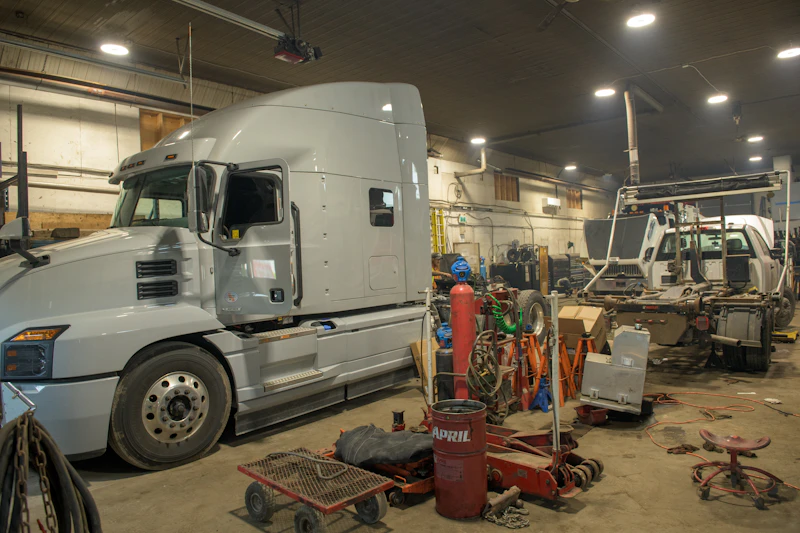Understanding Differential Gear Ratios in Heavy-Duty Trucks

Your heavy-duty trucks are the backbone of your industry, carrying huge loads, crossing demanding terrains, and covering thousands of miles each year. At the heart of your vehicle’s performance lies a critical component - the differential gear.
In this article, we'll take you into the world of differential gear ratios, explore how they influence the performance of these formidable machines, and help shed some light on which type is best suited to your fleet.
What is a Differential Gear?
To understand the impact of differential gear ratios, you need to know what a differential gear is. Essentially, a differential gear is a mechanical component situated between the drive wheels that allows the wheels on the same axle to rotate at different speeds. This is particularly useful when turning corners, and different wheel speeds are crucial for a smooth and stable movement.
The Significance of Differential Gear Ratios
Differential gear ratios, often simply referred to as gear ratios, are crucial to a truck's performance. These ratios determine how the engine's power is distributed to the drive wheels.
Explaining Gear Ratios in Detail
Gear ratios represent the number of times the drive shaft must rotate to make the wheels complete one revolution. For example, a 4.10 gear ratio means the drive shaft turns 4.10 times for every wheel revolution. A higher ratio, such as 4.56, would provide more torque, while a lower ratio, like 3.55, offers better fuel efficiency.
Types of Differential Gear Ratios
Heavy-duty trucks typically feature three main types of differential gear ratios:
Open Differentials
Open differentials are the most common type. They distribute power evenly to both wheels but tend to favor the wheel path of least resistance. While they are great for on-road driving, they may struggle in off-road or slippery conditions.
Limited-Slip Differentials
Limited-slip differentials strike a balance between open and locking differentials. They allow some difference in wheel speed but provide improved traction compared to open differentials. This can be a valuable feature for trucks that encounter variable terrain.
Locking Differentials
Locking differentials, also known as "lockers," are specifically designed for challenging terrain. They completely lock both wheels on an axle, ensuring equal power distribution. This is excellent for off-road situations but can be challenging to handle on pavement.
Impact on Truck Performance
Now that we've explored the different types of differential gear ratios, let's discuss how they impact your heavy-duty truck’s performance.
Acceleration
The choice of gear ratio significantly affects a truck's acceleration. Higher ratios provide more torque, making them ideal for heavy loads and quick starts. Lower ratios, on the other hand, contribute to better fuel efficiency during steady-speed cruising.
Towing
Differential gear ratios play a critical role when it comes to towing. Trucks with higher gear ratios can handle heavier loads more effectively, while those with lower ratios are better suited for long-distance hauling with reduced fuel consumption.
Off-Roading
For off-road enthusiasts, the right gear ratio can be a game-changer. Locking differentials, for example, can prevent wheel slippage in challenging terrain, ensuring power is evenly distributed to both wheels.
Choosing the Right Gear Ratio
Selecting the optimal gear ratio for a heavy-duty truck is a decision that should not be taken lightly. Various factors come into play.
Considerations for Choosing Gear Ratios
Payload: The weight of the load you typically carry should influence your gear ratio choice. Heavier loads may require higher gear ratios.
Terrain: The type of terrain you traverse plays a crucial role. Off-road and mountainous routes benefit from lower ratios, while flat highways favor higher ratios.
Intended Use: Determine whether your truck's primary function is long-haul trucking, short-haul deliveries, or off-road adventures.
Balancing Fuel Efficiency and Power
Finding the perfect gear ratio involves balancing power and fuel efficiency. Higher ratios provide more power but may sacrifice fuel economy. Lower ratios conserve fuel but may lack the necessary power for heavy-duty tasks.
Technological Advancements
The world of differential gear ratios is constantly evolving. Recent advancements have brought innovative solutions to heavy-duty truck performance.
Electronic Traction Control Systems
Electronic traction control systems have become increasingly sophisticated. These systems monitor wheel speed and apply brakes or reduce engine power to prevent wheel slippage, effectively mimicking the performance benefits of locking differentials.
Smart Differentials
Smart differentials are equipped with sensors and processors that can dynamically adjust power distribution to the wheels, optimizing traction and performance based on real-time conditions. Because of these benefits, they are becoming increasingly popular.
Maintenance and Adjustments
Proper maintenance of differential gear ratios is essential for prolonged truck performance. Regular checks and adjustments can make a significant difference.
Maintenance Tips
Regularly inspect the differential for leaks and ensure it is properly lubricated. Address any unusual noises or handle issues promptly.
Alternatively, you can take your heavy-duty truck to a reputable professional mechanic who can carry out the necessary checks and repairs for you.
Adjustments
In some cases, it may be necessary to adjust the gear ratio to suit changing needs, such as switching to a lower ratio for improved fuel efficiency or a higher ratio for increased power.
Final Thoughts
The impact of differential gear ratios on heavy-duty truck performance cannot be overstated. Your choice of gear ratio directly affects the acceleration, towing capacity, and off-road capabilities of your fleet. By understanding the different types of differentials and the considerations for selecting the right gear ratio, you can optimize your vehicles for specific tasks.
Choosing the right gear ratio is both a science and an art, and it's crucial to ensuring that your heavy-duty trucks perform at their best in their various roles.
So, the next time your heavy-duty truck conquers the road or trail, remember that the gear ratio beneath it plays a significant role in its impressive performance.


.webp)
.webp)